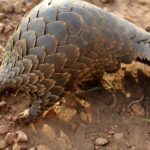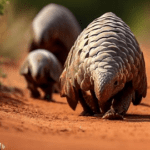Can Pangolins Fly? Pangolins – these scaly, mysterious creatures have captivated many. But, can they fly? Let’s find out!
Flight is a special ability possessed by birds, bats, and insects. Sadly, not pangolins. These elusive mammals may have great adaptations to survive, but flying isn’t one of them.
Pangolins have great features that set them apart! Their bodies are covered with overlapping keratin scales to protect against predators, and their tongues and claws can extract insects from crevices. But, still, no flight.
Unfortunately, pangolins are illegally traded for their scales, which are used in traditional medicine. This exploitation has had devastating consequences for their populations.
Vietnam’s Carnivore and Pangolin Conservation Program (CPCP) provides hope. It works to rehabilitate rescued pangolins and educate people about their importance. The CPCP is vital in safeguarding pangolins from further endangerment.
So, can pangolins fly? No, but we can appreciate them and treasure the natural world. Let’s stand together and be champions for pangolins, so future generations can thrive.
Key Takeaways
- Pangolins cannot fly; they are terrestrial animals that primarily walk on all fours.
- Despite their inability to fly, pangolins are excellent climbers and can use their strong claws to scale trees.
- Pangolins have a unique defense mechanism where they curl up into a ball when threatened, using their scales as protection.
- There are eight different species of pangolins, all of which are found in Africa and Asia.
- Pangolins are highly sought after for their scales and meat, making them one of the most trafficked animals in the world.
- Conservation efforts are crucial to protect pangolins from extinction, as their populations have been rapidly declining due to illegal hunting and habitat loss.
What are Pangolins?

Pangolins are known as scaly anteaters. They’re covered in keratin scales – the same material as our fingernails. Their long tongues help them catch ants and termites – their favorite meals. Pangolins are solitary creatures who live in burrows or tree hollows.
These amazing mammals have several special abilities. When threatened, they roll into a tight ball using their scales as protection. They have an incredible sense of smell, helping them find ant nests. Plus, their saliva is sticky enough to trap thousands of ants in one lick!
Unfortunately, pangolins are facing serious threats today. In 2017, authorities seized five tons of their scales in Indonesia. This illegal trade of pangolin scales and meat for human consumption is pushing them toward extinction. We must protect these awkward-looking superheroes!
Anatomical Features of Pangolins

Pangolins are one-of-a-kind creatures! Scientists and nature lovers are fascinated by their peculiar features. For example, they have sharp, overlapping scales made of keratin that form a protective armor. Plus, they have an incredibly long tongue (up to 40 cm) that helps them catch their favorite snack: ants and termites. Their curved claws help them climb trees and dig burrows. And, because pangolins are nocturnal, they have adapted big eyes and night vision.
Did you know that pangolins are the only mammals with scales? Their armor is so tough, it can even ward off predators like lions and tigers!
An exciting story about pangolins was discovered by researchers in their natural habitat. They observed a pangolin scaling a tree with ease. Shows how agile and talented they are! Just remember, if you see a pangolin flying, it’s time to take a break from the ‘shrooms and get some rest.
Do Pangolins Have the Ability to Fly?

Pangolins are famous for their scaly exterior – but sadly, they cannot fly. Even though they have impressive adaptations like their long tongues and sharp claws, they don’t have the ability to soar in the sky. They are great on land, instead.
But, they make up for their lack of aerial skills with other unique features. They are great climbers, able to effortlessly climb trees with their strong limbs and sharp claws. This helps them find food like ants and termites.
An interesting thing about pangolins is that they use their long, sticky tongues to catch their prey. Their tongues can extend up to 40 centimeters, so they can grab the insects without getting stung or bitten. This is a special adaptation they’ve evolved over time.
Even though they can’t fly, pangolins are still important. They play a big role in keeping the environment balanced by controlling the populations of ants and termites.
To protect these remarkable animals, we must take action. We should raise awareness of their importance and help fight the illegal wildlife trade. We must also preserve their habitats, so they can get the resources they need to survive. If pangolins had a motto, it would be: When in danger, just roll with it!
The Pangolin’s Unique Defensive Adaptations
The Pangolin is an amazing creature with unique defenses that make it stand out. Let’s learn about them!
It has tough overlapping scales of keratin, that provide great protection against predators. When in danger, it rolls up into a tight ball, making it impenetrable.
Also, it has powerful muscles in the tail to help it balance and also act as a weapon. With its long snout, it has a super sense of smell, to detect food and predators.
A true story of its defense: once in the forests of Southeast Asia, a predator came near a Pangolin. It quickly rolled itself into a ball, leaving the predator amazed. It was so impressed, it left in search of easier prey.
The Pangolin’s defenses are incredible! Its scales, tail, and sense of smell all help it survive in the wild. Its adaptations have evolved over time to allow it to thrive – even its flying skills are better than a brick!
Frequently Asked Questions
Q: Can Pangolins fly?
A: No, pangolins cannot fly. They are mammals with protective scales, but they lack wings and are not capable of flight.
Q: What are pangolins?
A: Pangolins are unique mammals found in Asia and Africa. They are covered in scales, have long tongues, and mainly feed on ants and termites.
Q: Are pangolins endangered?
A: Yes, pangolins are among the most trafficked mammals in the world, making them highly endangered. They are hunted for their scales and meat.
Q: How fast can pangolins move?
A: Pangolins are not known for their speed. They move at a slow pace, usually walking or using their long claws to dig into the ground.
Q: Can pangolins defend themselves?
A: Yes, pangolins have a unique defense mechanism. When threatened, they curl up into a tight ball, protecting their soft underbelly with their tough scales.
Q: Do pangolins have any predators?
A: While pangolins have few natural predators due to their protective scales, they may still fall victim to large cats, such as lions or tigers, or even humans who hunt them illegally.
Conclusion
No doubt about it – pangolins can’t fly! They don’t have wings, so the skies are off-limits. But they do have amazing skills on land. They’re pros when it comes to climbing trees and digging in the ground. Plus, they can curl up into a ball for self-defense. Super impressive!
Their scales are something special too. They’re made of keratin, the same material as human hair and nails. This makes them really tough – but sadly, it also makes them victims of illegal trafficking for their meat and scales. Conservation is key to saving these creatures.
In ancient Chinese folklore, pangolins were linked to mythical creatures like dragons and phoenixes. People thought they had magical powers, so they were highly coveted by emperors and nobles. This led to lots of hunting of pangolins throughout history.




